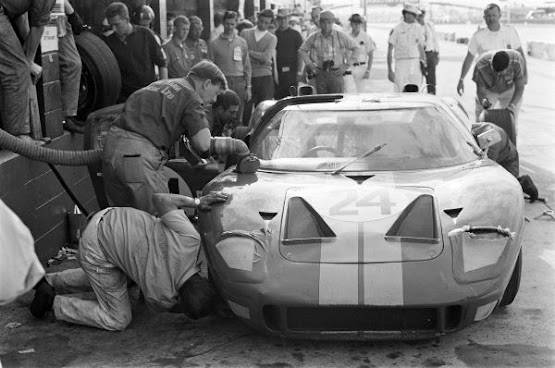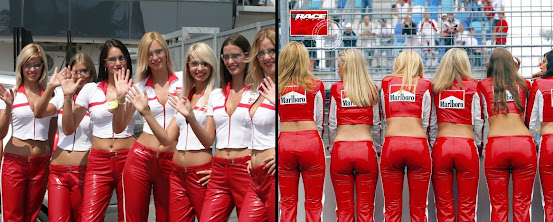Radar (pronounced rey-dahr)
(1) In electronics, a device for determining the presence
and location of an object by measuring the time for the echo of a radio wave to
return from it and the direction from which it returns (originally the acronym RA(dio)D(etecting)A(nd)R(anging)).
(2) Collectively, the hardware & software used in
such systems.
(3) Figuratively, a means or sense of awareness or perception.
(4) Modified as "gaydar", an informal description of one's ability to "sense" who might be "gay", the most refined systems with graduations including also: "a bit of a homosexual", "suspected homosexual", "possible homosexual" & "probable homosexual".
1940–1945: An acronym (RADAR: RA(dio)D(etecting)A(nd)R(anging)), coined in the US and entering English as a word within
years. Specialized forms are created as
needed (radar gun, radar zone, radar tower, radar trap etc); radar is a noun,
verb & adjective; the noun plural is radars.
Although it wouldn’t for a few years be known as radar,
the system first became well known (within a small community on both sides of
the English Channel) in 1940 because the string of radar installations along
the English coast played such a significant role in the Royal Air Force’s (RAF)
defense during the Battle of Britain, the crucial air-war fought that summer. What the radar did was to provide sufficient
notice of an attack to enable RAF Fighter Command to react to threats in the
right place at the right time (altitude was always a problem to assess) by “scrambling”
squadrons of aircraft on stand-by rather than having to maintain constant
patrols in the sky, something which rapidly would have diminished resources.
There was some criticism that after some early attacks on
the radar installations, the Luftwaffe didn’t persist, much to their
disadvantage as it transpired. In fact,
the early attacks were successful and for periods, the ground controllers
substantially were “blind” but the Germans could only attack what they could
see and this was the masts and wires along the coast, easily and quickly able
to be repaired. The Germans knew what
the radar was doing and suspected the advantage it offered the defenders but
because their early attacks on the towers and wires, although clearly destructive,
appeared to do little to diminish the RAF’s ability to respond, they switched
to other targets. The towers and wires
were actually just a part of a system, much of which was underground, and it
was the connectivity between the controllers receiving & interpreting the
radar data, the sector stations and the fighter squadrons which made the RAF so effective. Technically, the way the British implemented radar was an inefficient "brute-force" approach but it worked well and was able to be built and repaired quickly. RAF was also an interesting example of how
acronyms are adapted for use. The
British traditionally sounded RAF as the letters R-A-F rather than “raff” but
when the Royal Australian Air Force (RAAF) was formed, they adopted the form “raff”,
presumably as a point of differentiation and, the Australians being never fond
of wasted effort, something like “R-double-A-F” would have been a bit much.
Although some have tried to be prescriptive about forms
of use and for centuries others have published style guides and books of “rules”,
English tends still to evolve organically and words, “rules” and conventions
come and go; only the strong survive in this laboratory of linguistic
Darwinism. The transition of an acronym
to a recognized "word" is an example of some of the processes
involved and although the proliferation of acronyms is certainly a recent phenomenon,
they’ve actually be around at least since Antiquity, their initial attractions
being they saved space on the expensive material on which stuff was written,
they meant a scribe or scholar saved time (some paid by the hour or even the characters
used) and generally, they made texts easier to read. However, in the West, it was during World War
I (1914-1918) that the growth in the number of acronyms really began, the
military taking to them with a glee which soon infected the rest of government.
Etymologists note the trend of construction beginning
early in the twentieth century before the great spike during the Great War but
the word acronym seems not to have entered English until 1943. It was borrowed from the circa 1902 German Akronym,
from the Ancient Greek ἄκρον (ákron) (end, peak) & ὄνυμα (ónuma) (name),
the construct being acro- (high;
beginning) + -(o)nym (name) and modeled after two other
German nouns from semantics “homonym” (word with the same sound and spelling as
another but different meaning) & Synonym (a word with the same meaning as
another word). For most of us, whatever
looks like an acronym is an acronym among the specialists for who structural
linguistics is a profession, a calling or an obsession (there’s often overlap),
there are distinctions. They will insist
that an acronym is a construction which is always sounded as a word (eg UNESCO,
the United Nations Educational, Scientific & Cultural Organization which is
pronounced yoo-nes-koh) whereas one (certainly
since the mid 1950s) where the letters are sounded as letters (eg BBC, the British
Broadcasting Corporation which is pronounced bee-bee-see) is an initialism.
Initialism actually had its own history: in mid-nineteenth century
academic publishing it was used in the sense of “group of initial letters of an
author's name (rather than the full name) atop a published paper” and an
earlier term for what is now known as an initialism “alphabetic abbreviation”,
dating from 1907.
Lindsay Lohan on the cover or Radar magazine, June-July 2007. The last print-edition of Radar was in 2008; since 2009 it's been released on-line.
For most folk their handling of such things has little to do with the structural distinctions but is more pragmatic and based on linguistic convenience and administrative convenience. When typing, www makes more sense than “world wide web” yet in speech the full version is an economic three syllables, unlike the acronym which takes a time-consuming nine and is thus rare. In the 1990s, “dub-dub-dub” was suggested as an alternative but it never caught on. There are also situations where an acronym may be a homophone of another word so while ETA (the acronym for Euskadi Ta Askatasuna (Basque Homeland and Liberty), the armed left-wing separatist organization in Spain’s Basque Country) was pronounced etta, the Bougainville Revolutionary Army (an armed secessionist movement of Bougainvilleans seeking independence from Papua New Guinea (PNG)) enjoyed the acronym BRA but it was never spoken as brah but always B-R-A. So, the constructions which most regard as acronyms (or variations of the breed) consists of eleven types:
(1) Pronounced as a word, containing only initial letters (eg TIFF: True Image File Format; pronounced tif), (2) Pronounced as a word, the construct a mix of initial and non-initial letters (eg Radar: RA(dio)D(etecting)A(nd)R(anging); pronounced ray-dar), (3) Pronounced as a mix of letters and a word (eg JPEG: Joint Photographic Experts Group; pronounced jay-peg (although the variation jay-pee-gee is widespread because the file-name format used by CP/M in the 1970s and PC/MS-DOS in the 1980s in which file names used a string of up to eight characters, followed by a period, followed by an type-identifying file-name extension of up to three characters meant JPEGs were named filename.jpg), (4) Pronounced as a string of letters (eg BBC: British Broadcasting Corporation; pronounced bee-bee-see), (5) Pronounced as a string of letters, but with an interpolated verbal shortcut (eg National Health & Medical Research Council: NH&MRC; pronounced enn-aitch-and-emm-are-see), (6) A Shortcut incorporated into a name (eg SCO: the Santa Cruz Operation; pronounced sko) (7) The mnemonic (eg KISS: Keep It Simple, Stupid; pronounced kiss), (8) The self-referential (eg TLA: Three Letter Acronym; pronounced tee-elle-eh), (9) The interpolated acronym (eg GIMP: GNU Image Manipulation Program; pronounced gimp), (10) Pseudo-acronyms (eg K9: pronounced key-nahyn (ie canine) which when sounded invoke a word or phrase (thus technically gramograms) and (11) The dreaded internally redundant acronym where a word (usually the last) is duplicated (eg ATM: Automated Teller Machine which is often used as ATM machine). Despite the duplication, "ATM machine" seems to have entered the language so it's unusual in that in English the trend usually is to eliminate words where possible so forms are shorter.
The ATM machine might be OK if ATM had become a word (a la
radar) but it never did. Why some
acronyms enter English as genuine stand-alone words while others never do is
influence by a number of things but there are certainly no defined rules:
(1) Frequency of Use: If an acronym is used widely and
frequently it can come to be accepted as a word: Thus, while NACA (National
Advisory Committee for Aeronautics never reached critical mass, it’s successor
organization NASA (National Aeronautics and Space Administration) certainly
did.
(2) Ease of use: The effortlessness with something rolls off
the tongue will influence acceptance.
Radar and scuba (self-contained underwater breathing apparatus) both
benefited from this but sometimes an acronym’s creators may have wished they’d
thought of something less amenable: In 1972, Richard Nixon's (1913-1994; US
president 1969-1974) campaign staff created the "Committee to Re-elect the
President" which they abbreviated to CRP but the (usually hostile) press
of course prefered CREEP and that's how it's remembered. As it turned out, the journalists were right;
in addition to fund-raising, printing flyers and producing bumper stickers,
CREEP also engaged in back-channel deals and dirty-tricks operations.
(3) Portability: If an acronym is used in ways other than
for the original purpose, it’s more likely to become a word. Radar came to be used in many figurative ways
and even spawned the imaginative “gaydar” (a portmanteau word, a blend of gay +
(ra)dar, a colloquialism describing an individual’s (deductive or intuitive)
ability to identify another as gay when it’s not immediately obvious through
visual or other clues.
(4) Lexical Adaptation: The more an acronym can be
adapted to fit standard grammatical rules, the more quickly it might be
accepted as a word; laser (Light Amplification by Stimulated Emission of Radiation) & radar both quickly
came into use as nouns.
(5) Duration of use: The longer an acronym is in use, the
more likely it will become ingrained in the lexicon. Of course notoriety can transcend time: The
Nazi Gestapo (Geheime Staatspolizei (Secret State Police))
existed for barely a dozen years but remains so notorious it’s part of
language, used especially in political discourse when critiquing the powers of
the state.
(6) The lexicographical imprimatur: If the editors of dictionaries accept a word and grant it an entry, there’s probably no more significant step for an acronym on the way to word-hood. Of course, an entry in an established publication (preferably one with at least a history of print editions) suggests legitimacy in a way that on-line versions curated by users may not but English in such matters also works by acclamation and it may be some acronyms which became words really did first appear in the very often helpful Urban Dictionary.

















